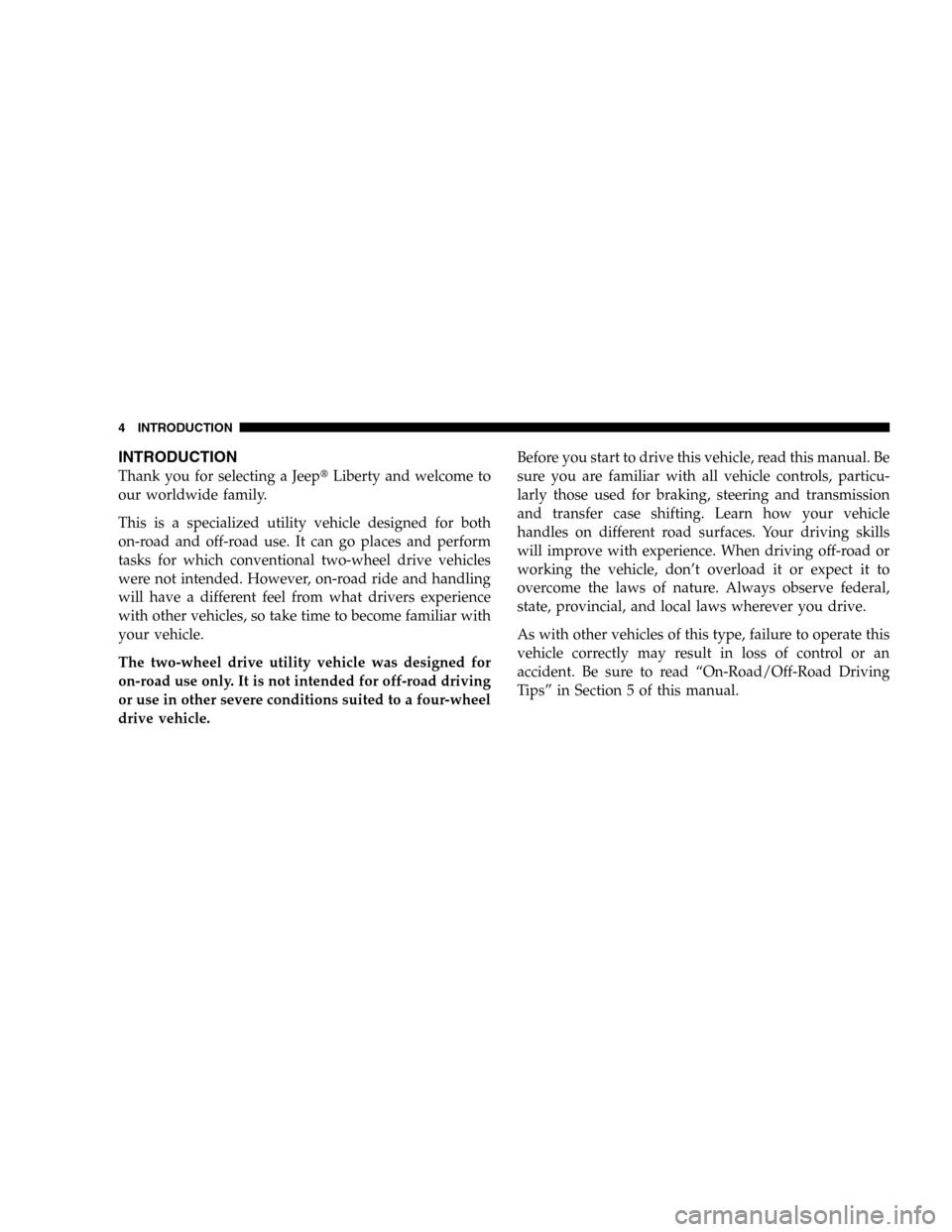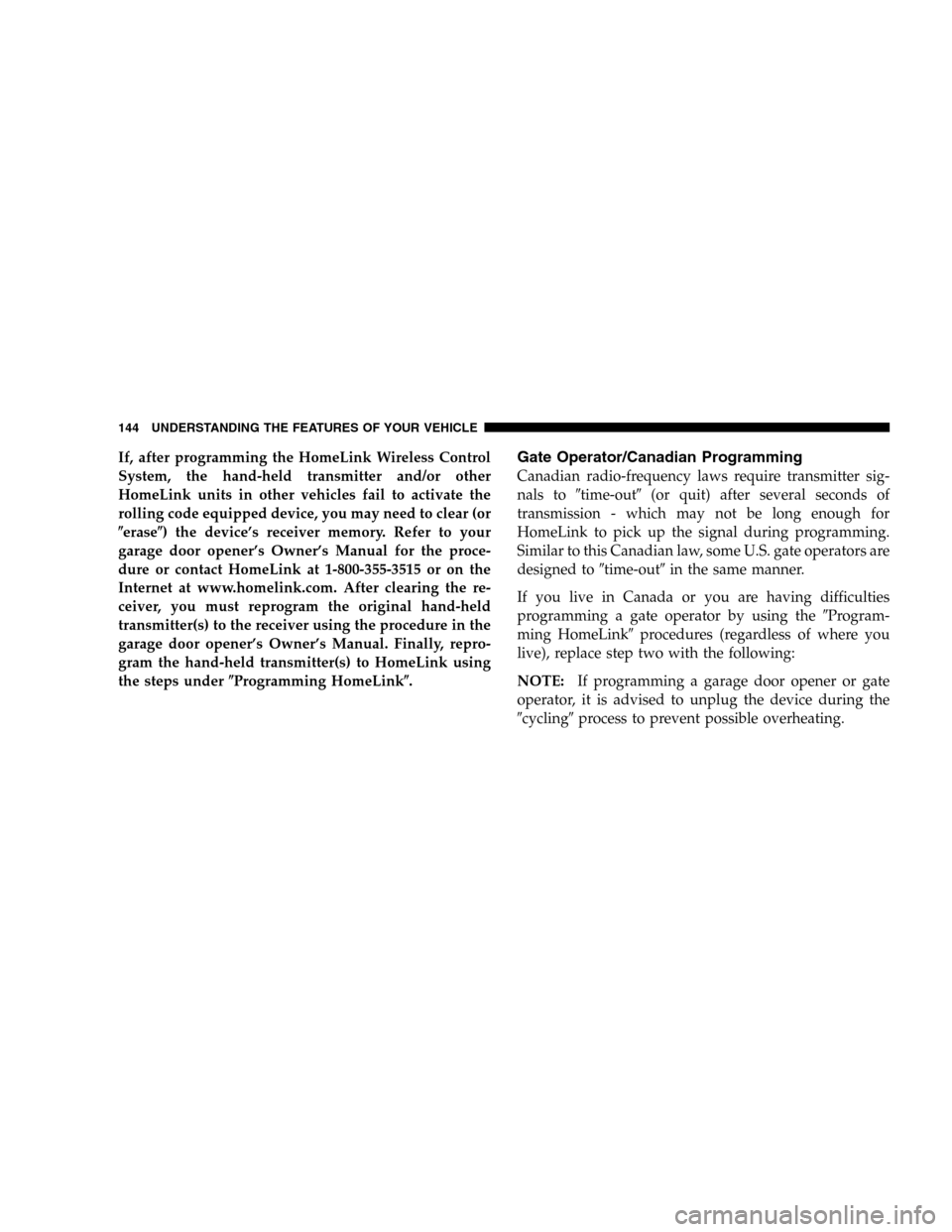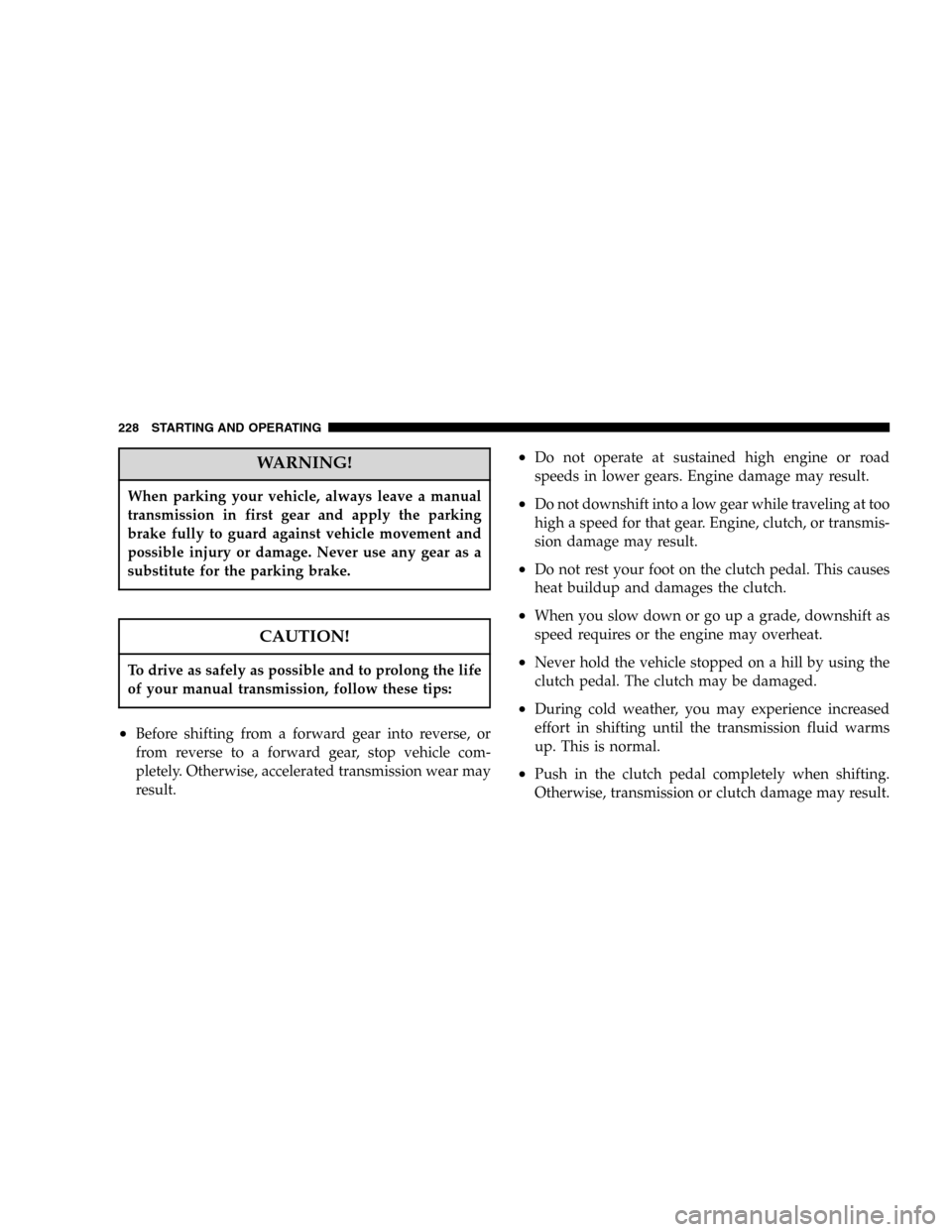Page 4 of 424

INTRODUCTION
Thank you for selecting a Jeep�Liberty and welcome to
our worldwide family.
This is a specialized utility vehicle designed for both
on-road and off-road use. It can go places and perform
tasks for which conventional two-wheel drive vehicles
were not intended. However, on-road ride and handling
will have a different feel from what drivers experience
with other vehicles, so take time to become familiar with
your vehicle.
The two-wheel drive utility vehicle was designed for
on-road use only. It is not intended for off-road driving
or use in other severe conditions suited to a four-wheel
drive vehicle.Before you start to drive this vehicle, read this manual. Be
sure you are familiar with all vehicle controls, particu-
larly those used for braking, steering and transmission
and transfer case shifting. Learn how your vehicle
handles on different road surfaces. Your driving skills
will improve with experience. When driving off-road or
working the vehicle, don’t overload it or expect it to
overcome the laws of nature. Always observe federal,
state, provincial, and local laws wherever you drive.
As with other vehicles of this type, failure to operate this
vehicle correctly may result in loss of control or an
accident. Be sure to read “On-Road/Off-Road Driving
Tips” in Section 5 of this manual.
4 INTRODUCTION
Page 15 of 424
To remove the ignition key on models with a manual
transmission, depress and hold the key release button,
turn the ignition key to LOCK and remove the key.WARNING!
Leaving children in a vehicle unattended is danger-
ous for a number of reasons. A child or others could
be injured. Children should be warned not to touch
the parking brake, brake pedal, or the gear selector
lever. Do not leave the keys in the ignition. A child
could operate power windows, other controls, or
move the vehicle.
CAUTION!
An unlocked vehicle is an invitation to thieves.
Always remove the key from the ignition, and lock
all doors when leaving the vehicle unattended.
Ignition Key Release Button
THINGS TO KNOW BEFORE STARTING YOUR VEHICLE 15
2
Page 19 of 424

2. This device must accept any interference that may be
received, including interference that may cause undes-
ired operation.
STEERING WHEEL LOCK — IF EQUIPPED
Your vehicle may be equipped with a passive steering
wheel lock (manual transmission only). This lock pre-
vents steering the vehicle without the ignition key. If the
steering wheel is moved a half turn in either direction
and the key is not in the ignition, the steering wheel will
lock.
To Manually Lock the Steering Wheel
With the engine running, rotate the steering wheel 1/2
revolution from straight ahead position, turn off the
engine and remove the key. Rotate the steering wheel
slightly in both directions until the lock engages.
To Release the Steering Wheel Lock
Insert the key in the ignition and turn the wheel slightly
to the right or left to disengage the lock.
NOTE:If you turned the wheel to the right to engage
the lock, you must turn the wheel slightly to the right to
disengage it. If you turned the wheel to the left to engage
the lock, turn the wheel slightly to the left to disengage it.
ILLUMINATED ENTRY
The interior lights come on when you open any door.
They will remain on for about 30 seconds after all doors
are closed then fade to off, unless, the dome inhibit
feature was selected on the multi-function control lever.
Refer to LIGHTS in Section 3 of this manual.
The lights also will fade to off if you turn on the ignition
after you close all the doors.
THINGS TO KNOW BEFORE STARTING YOUR VEHICLE 19
2
Page 144 of 424

If, after programming the HomeLink Wireless Control
System, the hand-held transmitter and/or other
HomeLink units in other vehicles fail to activate the
rolling code equipped device, you may need to clear (or
�erase�) the device’s receiver memory. Refer to your
garage door opener’s Owner’s Manual for the proce-
dure or contact HomeLink at 1-800-355-3515 or on the
Internet at www.homelink.com. After clearing the re-
ceiver, you must reprogram the original hand-held
transmitter(s) to the receiver using the procedure in the
garage door opener’s Owner’s Manual. Finally, repro-
gram the hand-held transmitter(s) to HomeLink using
the steps under�Programming HomeLink�.Gate Operator/Canadian Programming
Canadian radio-frequency laws require transmitter sig-
nals to�time-out�(or quit) after several seconds of
transmission - which may not be long enough for
HomeLink to pick up the signal during programming.
Similar to this Canadian law, some U.S. gate operators are
designed to�time-out�in the same manner.
If you live in Canada or you are having difficulties
programming a gate operator by using the�Program-
ming HomeLink�procedures (regardless of where you
live), replace step two with the following:
NOTE:If programming a garage door opener or gate
operator, it is advised to unplug the device during the
�cycling�process to prevent possible overheating.
144 UNDERSTANDING THE FEATURES OF YOUR VEHICLE
Page 217 of 424
STARTING AND OPERATING
CONTENTS
�Starting Procedures.....................220
▫Manual Transmission..................220
▫Automatic Transmission................220
▫Normal Starting — Gasoline Engines.......221
▫Normal Starting — Diesel Engines.........223
▫Diesel Fuel-Water Separator..............225
▫Re-Priming The Diesel Fuel System........225
�Engine Block Heater — If Equipped.........226
�Transmission Shifting....................227▫6-Speed Manual Transmission............227
▫Automatic Transmission................230
▫Rocking The Vehicle...................236
�Four-Wheel Drive Operation...............236
▫Command-Trac�Operating
Information/Precautions................236
▫Shift Positions........................238
▫Shifting Procedure....................239
▫Selec-Trac�Operating Information/Precautions —
If Equipped.........................240
5
Page 220 of 424

STARTING PROCEDURES
Before starting your vehicle, adjust your seat, adjust both
inside and outside mirrors, and fasten your seat belts.
WARNING!
Do not leave children or animals inside parked
vehicles in hot weather. Interior heat build up may
cause serious injury or death.
Manual Transmission
Apply the parking brake, place the gearshift control lever
in N (Neutral) and depress the clutch pedal before
starting vehicle. This vehicle is equipped with a clutch
interlocking ignition system, which requires the clutch to
be fully depressed before starting the vehicle.4WD Models Only
In 4L mode, this vehicle will start regardless of whether
or not the clutch pedal is pressed to the floor. This feature
enhances off-road performance by allowing the vehicle to
start when in 4L without having to depress the clutch
pedal. The 4 LO MODE indicator light will illuminate
when the transfer case has been shifted into this mode.
Automatic Transmission
Start the engine with the selector lever in the N (Neutral)
or P (Park) position. Apply the brake before shifting to
any driving range.
220 STARTING AND OPERATING
Page 227 of 424
WARNING!
Remember to disconnect the cord before driving.
Damage to the 110-115 volt AC electrical cord could
cause electrocution.
Use the heater when temperatures below 0°F (-18°C) are
expected to last for several days.
TRANSMISSION SHIFTING
6-Speed Manual Transmission
Follow the shift pattern on the gearshift knob.
NOTE:The backup lights will come on when your
vehicle is in R (Reverse) gear and the ignition is in the ON
position.Manual Shift Controls
STARTING AND OPERATING 227
5
Page 228 of 424

WARNING!
When parking your vehicle, always leave a manual
transmission in first gear and apply the parking
brake fully to guard against vehicle movement and
possible injury or damage. Never use any gear as a
substitute for the parking brake.
CAUTION!
To drive as safely as possible and to prolong the life
of your manual transmission, follow these tips:
•Before shifting from a forward gear into reverse, or
from reverse to a forward gear, stop vehicle com-
pletely. Otherwise, accelerated transmission wear may
result.
•Do not operate at sustained high engine or road
speeds in lower gears. Engine damage may result.
•Do not downshift into a low gear while traveling at too
high a speed for that gear. Engine, clutch, or transmis-
sion damage may result.
•Do not rest your foot on the clutch pedal. This causes
heat buildup and damages the clutch.
•When you slow down or go up a grade, downshift as
speed requires or the engine may overheat.
•Never hold the vehicle stopped on a hill by using the
clutch pedal. The clutch may be damaged.
•During cold weather, you may experience increased
effort in shifting until the transmission fluid warms
up. This is normal.
•Push in the clutch pedal completely when shifting.
Otherwise, transmission or clutch damage may result.
228 STARTING AND OPERATING